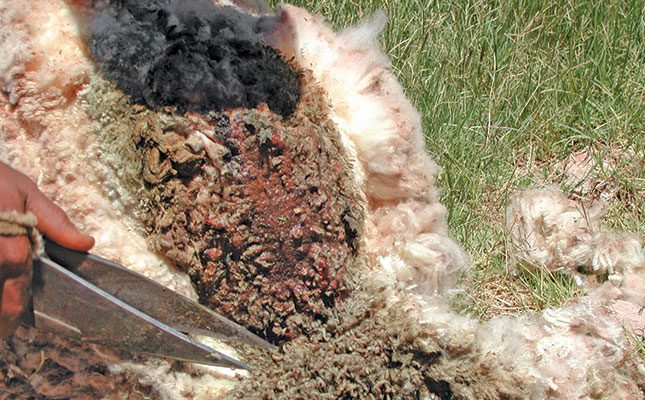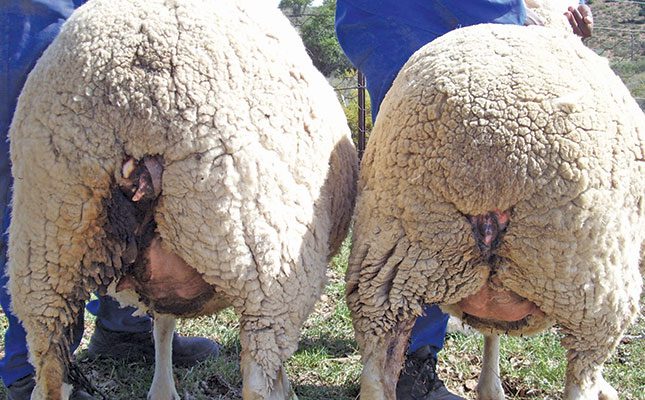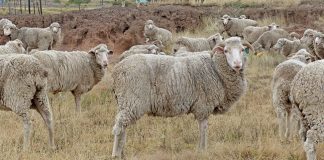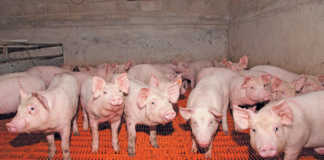
Photo: Roelof Bezuidenhout
Trials carried out a few years ago by Cape Wools at Tygerhoek Research Farm to evaluate the need for tail docking in Merino sheep found very little difference in breech (blowfly) strike between lambs that had been docked and those whose tails were left intact.
The trials were conducted because it had becoming increasingly important for wool growers to justify the need for husbandry practices that might cause temporary discomfort to sheep or lambs.
READ Meat, milk or wool: choose a sheep breed fit for purpose
The researchers wanted to know whether tail docking influenced the prevalence of breech strike, affected weight gain, and helped to ease shearing, as well as whether long tails affected reproduction.
The tails of lambs in the control group were left intact, while the tails of lambs in the treatment group were docked with a hot iron at the third palpable joint at about three weeks of age. Lambs were randomly allocated to either treatment within sexes.
Of the 161 tail-intact lambs (control group), 12 suffered from breech strike (7,5%), while 14 docked lambs out of 164 (8,5%) were similarly affected. It was therefore evident that no treatment effect was present.
While it was unclear whether tail docking had an effect on reproduction, weaning weight was not affected by the treatment. Nor did tail docking have any influence on shearing, either in terms of time spent per sheep or the welfare of the sheep during the shearing.
Too short
In an article in Beyond the Bale, Australian Wool Innovation recommends that the best practice is to dock tails at three or four joints. Docking a tail too short can lead to increased predisposition to rectal prolapse, increased danger of skin cancer of the perineal region, higher risk of bacterial arthritis and greater risk of breech strike, as the ewe cannot raise its tail to defecate or urinate or flick flies away.
This means that short tails tend to lead to higher dag formation (a lock of wool matted with dung hanging from the hindquarters of a sheep) and, in ewes, more urine staining of the wool.
READ A basic checklist to keep sheep healthy and productive
The article quotes a veterinarian as saying that most arthritis in Australian sheep is caused by bacterial infection due to bacteria entering the sheep’s bloodstream via a wound. Even a skin tear is enough to introduce bacteria, and short tail docking is especially problematic.
When tails are docked too short, more muscle and tissue are involved and the wound takes longer to heal. As a result, it has more chance of becoming infected.
According to the article, research conducted in the 1930s and 1940s before flystrike preventative chemicals were available reported that the flystrike rate in short-tailed sheep was more than double that in long-tailed sheep.
In long-tailed sheep, 13 sheep out of 100 had fly strike, in medium-tailed sheep the rate was 27 per 100, and in short-tailed sheep it was 38 per 100.
Best length
The best place at which to dock a sheep’s tail is in the vertebral space after the third or fourth palpable joint.
The remaining tail should cover the vulva in a ewe and be the same length in a ram or wether. The bare area on the underside of the tail should never be cut through. Leaving it intact enables the animal to lift its tail to defecate and urinate.
A very short tail exposes the breech to sunlight, which can lead to cancers of the perineal region.

Research conducted in the 1980s found squamous cell carcinomas present in flocks on 82% of farms surveyed. The prevalence of cancers ranged from 0,12% to 4% of ewes, and increased with age. More than 3% of ewes over five years of age were affected.
Rectal prolapse is also more common in sheep with short-docked tails, due to muscle damage.
If sheep are coughing from pneumonia (common in all sheep-raising regions of Australia), they are far more likely to suffer rectal prolapse where the tail has been docked too short.
Prolapse is generally fatal.
In short, there is no good reason for a short tail, according to the Beyond the Bale article.
Breeding naturally flystrike-resistant sheep can take from five years to several decades. A survey suggests that wool growers in Australia are seeing their breeding programmes coming to fruition, giving them the confidence to cease mulesing, where flaps of skin from around a lamb’s breech and tail are cut off using sharp shears to reduce the risk of flystrike.
Docking tips
- Don’t let the lambs walk far before and after treatment.
- Dock as early as possible, but not within the first week of lambing.
- Don’t dock weak or sick lambs.
- Administer a fly repellent pour-on and disinfectant.
- Place treated lambs in a clean pen immediately after treatment to prevent infection.











